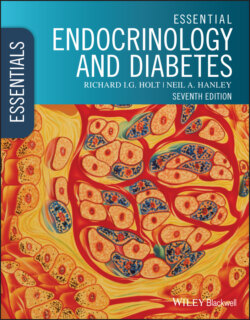Читать книгу Essential Endocrinology and Diabetes - Richard I. G. Holt - Страница 64
Box 3.4 Defects in the insulin signalling pathways and ‘insulin resistance’ syndromes
ОглавлениеOver 50 mutations have been reported in the insulin receptor (IR) that impair glucose metabolism and raise serum insulin (‘insulin resistance’).
Historically, insulin receptor mutations have been discovered as different congenital syndromesThe advance of molecular genetics has unified these diagnoses as a phenotypic spectrum according to the severity of IR inactivation.
People with milder insulin resistance and less affected IR signalling are usually only diagnosed at puberty, whereas what was known as ‘Leprachaunism’, with an effective absence of functional IR, manifests as severe intrauterine growth retardation.
People with severe insulin resistance rarely survive beyond the first year of life.
Interestingly, the IR gene is seemingly normal in most people with milder congenital insulin resistance, suggestive of abnormalities in other components of insulin signalling pathways.
Some of these monogenic causes of insulin resistance have now been discovered.
Impaired insulin signalling is also a significant component of type 2 diabetes (Chapters 11 and 13).
Figure 3.7 Growth hormone (GH) signalling and its antagonism. GH binds to its cell‐surface receptors and, via altered conformation of the receptor dimer, recruits Janus‐associated kinase 2 (JAK2). Understanding this model led to the design of the GH receptor antagonist, pegvisomant.
